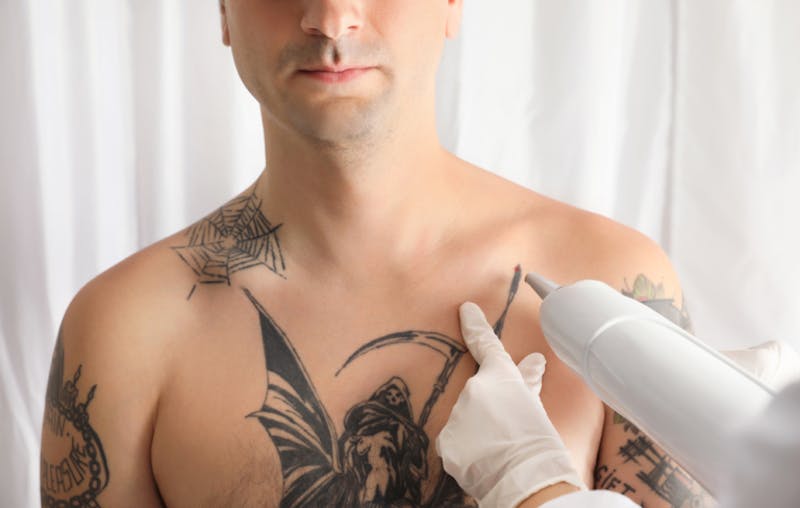
A tattoo is meant to be permanent, but in many cases, people regret their decision to get one. We often change our minds about life and love as we get older, and youthful decisions don’t always hold up over time. Unwanted body art may be also driving away professional opportunities and social connections. Today, tattoo removal is an advanced art form, and at Cosmetic Vein & Laser Center in Williamsville, NY we are expert practitioners.
How Long Does Laser Tattoo Removal Take?
You may have had your tattoo done for you in just a few hours. Removal sessions are even shorter, but full results will take months for complete effect. Each case is as different as every individual tattoo, so there’s no one timetable for success. Many factors impact the length of time it will take for removal, including the size and age of the tattoo, your individual skin tone and condition, and even the ink colors that are being removed.
The amount of time it takes for your tattoo to become history can be understood as a series of steps. Obviously, most of the work is being done by the laser specialist. That said, your own body is a major collaborator in this treatment. In addition to absorbing and eventually eliminating the unwanted inks, your skin has to heal over and rejuvenate itself with fresh tissue. The removal timeline can be broken down into the following way:
The Length of the Sessions
A single session of laser removal can be as short as a few minutes for a small tattoo and as long as an hour or more for a large, complex design. Many tattoos contain multiple colors, which require different wavelengths from the laser treatment, which adds time. In most cases, multiple sessions are needed to eliminate the tattoo.
The Number of Sessions
Multiple factors will determine the correct number of laser sessions for successful removal. Size and color have already been mentioned, as has skin tone – the effects of laser treatment work differently for different combinations of complexion and ink color. Because the skin needs several weeks to heal after a removal session, the more sessions that are needed, the longer the removal process will take.
The Recovery and Results
Some tattoos are gone after only a few months, but large or elaborate designs can take as long as a year or more to fade from visibility. Because your body is doing the work of absorbing the laser-treated inks and then regenerating fresh tissue over the treated area, your immune system has a major role to play. Helping your immune system with proper diet, hydration, and vitamin intake can help speed the process.
Different Kinds of Tattoos
To a significant degree, the specifics of where (and how) the tattoo was applied, as well as where it’s located on your body, shape the timeline for removal. Generally, tattoos and other unnatural skin colorations come from one of four sources:
Amateur Work
Letting a novice make a permanent design on your body generally isn’t the best idea, but it’s widely done nonetheless – everywhere from suburban basements to prison cells. Ironically, these home-made tattoos are actually easier for professionals to remove. Amateurs don’t go as deeply into the skin as professionals do, and the inks they use are usually less stable than those used by professionals. If you want to get rid of an amateur tattoo, you’re already at an advantage.
Professional Tattoos
A professional tattoo artist works more deeply into the skin, and generally uses higher-quality inks that are designed to last. Unfortunately, there are thousands of different inks in use today and none of them are FDA-approved. That means that in addition to the other specifics, such as the size and colors of the tattoo and your skin tone, the laser removal specialist will have to take into account how much ink your body can safely absorb after a session.
Surgical Tattoos
Certain medical treatments, such as radiation therapy, require small tattoos in the area that will be treated. There are two reasons for this. The first is precision; the technicians need to be able to aim the beams exactly right with each session. Second, if radiation becomes necessary again years later, the technicians will know where to work. These tattoos can be traumatic reminders of cancer treatment or other therapies. They’re usually small, and depending on location, easy to remove.
Traumatic Tattoos
Many unwanted skin colorations are caused by external trauma, such as a burn or exposure to a caustic chemical. Other unwanted skin markers, such as port-wine stains, are caused by internal problems, in this case, an abnormal cluster of blood vessels. While these marks aren’t tattoos, their effects can be just as stigmatizing. A laser tattoo removal specialist can usually remove these marks with complete success.
What Is the Treatment Like?
Tattoos are made up of ink particles that have been embedded into the skin. While the body usually absorbs foreign particles and flushes them out naturally, ink particles are too big to be absorbed, so they stay intact in the pattern that the artist drew. Laser tattoo removal uses selective pulses of energy to break up these particles into smaller pieces so they can be absorbed by the body and disappear from visibility.
The treatment is performed with a wand that aims the laser pulses. The pulses perform two related functions. The main task is breaking up ink pigments by inducing a thermal (heat) reaction to specific colors in the tattoo, using different wavelengths in the laser. In effect, those colors are being melted away into absorbable particles. The second effect comes from the power of the laser pulse. The impact of the pulse itself helps to break up ink particles of all colors.
Understanding the Variables
In the early days of laser removal, the technologies were less effective on some colors than others. Black and dark blue ink were the easiest colors to fix, while colors like green and purple were the most difficult. Today’s state-of-the-art equipment can handle all colors, and without the problem of scarring, that was a byproduct of earlier systems. Our practice uses the latest laser technologies, but the treatment strategy will be affected by the following factors:
Size of the Tattoo
This one is easy to understand – the more ink there is, the more time it takes for the laser to break it up. The amount of laser treatment that’s safe and appropriate for a single session varies, because it’s important to give the skin time to recuperate after each one. Large and oversized tattoos take longer to fix over multiple sessions. Small ones, however, might require only minutes of treatment and can heal in a few short months.
Skin Color
The color and tone of your skin are important factors in achieving the desired effects of your removal. It’s important that the removal look natural and not eventually produce a different skin pigmentation that may be almost as noticeable as the old tattoo. The Fitzpatrick Scale is a classification system for complexions that guides today’s dermatological work. The scale classes humans into six shades of color. The scale was originally developed to help people avoid sunburn.
Location
The actual location of the tattoo on the body plays a part in determining treatment. For example, the skin on your fingers has a different density than the skin on your back. While all skin areas can be treated by the laser, there can be swelling and minor discomfort after treatment, and tattoos that are in sensitive spots of the body must be treated gently and gradually.
The Kirby-Desai Scale
This powerful assessment tool for tattoo removal was introduced in 2009. This system assigns a numerical score to six different parameters for each patient that guides the strategy for removal and often determines the number of sessions needed. Scores are assigned for skin type, where on the body the tattoo is located, the colors to be removed, the amount of ink present, the amount of any scar tissue, and whether the tattoo has been layered by multiple designs.
How Long Before It’s Gone?
Naturally, there’s no one answer to this question. Everyone’s skin and body metabolism are as individual as their tattoos. Your body’s self-repair systems are what eventually grow over the deleted tattoo, and its ability to do that job depends on your state of health, your lifestyle, and to a certain extent, your age. In a very broad sense, you can expect to see improvement in a matter of months, but the full fading effect can take a year.
What’s the First Step?
The biggest step in getting rid of a tattoo is the first one — deciding that you finally want to do it. Many tattoos are regretted as soon as they’re done, while others are cherished for years before they become unwanted. In either case, nobody wants to live with a permanent branding on their body that may not mean so much to them anymore.
Besides the negative emotions that an unwanted tattoo inspires, there’s the issue of how other people see you – and your tattoos. Many employers frown on tattoos, and many potential friends may be put off by their own personal feelings about them. An unwanted tattoo is a regret, but it no longer has to be a permanent one.
Remorse Is OK
If you’re thinking about getting your tattoo removed, know that you’re not alone. “Tat remorse” is extremely common, with some surveys reporting that up to 78% of tattoo recipients feel regret about their choice, sometimes within just days of getting it done. Many report that they don’t like how it looks once they get older (or never did like it). Other times they feel that they are being judged by others, in subtle or not-so-subtle ways, by their tattoos.
Research consistently shows that about 1 in 9 people in the U.S. who have one or more tattoos ultimately have at least one removed. Twelve percent of any surveyed group is a robust number, but when you consider that nearly 1 in 3 Americans are tattooed – more than 100 million people — you can easily see how you are not alone you are in your decision. There’s no stigma in seeking to remove something you no longer want on your body.
Expert Results
Removing a tattoo is as much of an artform as applying one in the first place It takes skill, experience, and the right technologies to produce the clean slate on your skin that you’re looking for. Our experienced clinicians can make tattoos of all types fade into memory, with a 95% reduction in visibility. We can help you undo the look that you no longer want to live with. Call Cosmetic Vein & Laser Center in Williamsville, NY today to schedule an appointment.


